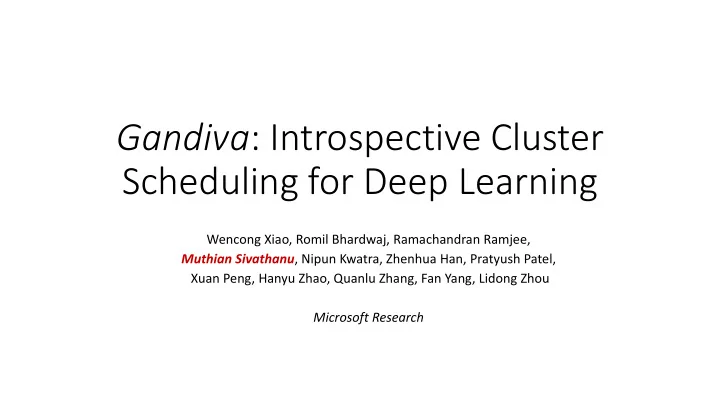

Gandiva : Introspective Cluster Scheduling for Deep Learning Wencong Xiao, Romil Bhardwaj, Ramachandran Ramjee, Muthian Sivathanu , Nipun Kwatra, Zhenhua Han, Pratyush Patel, Xuan Peng, Hanyu Zhao, Quanlu Zhang, Fan Yang, Lidong Zhou Microsoft Research
Deep learning: An important cloud workload • Growing impact: Consumer products – Web search, Alexa/Siri/Cortana,… • Upcoming: Enterprise uses (e.g. medical diagnosis, retail) • DL jobs are compute-intensive, so need expensive custom hardware • Dominant platform today: GPUs • Cloud vendors run large clusters of GPUs ( billions of $ ) • Efficient use of GPU clusters crucial to manage cost of DL innovation
Deep Learning Training (DLT) • Build a model for an end-to-end application (e.g. speech2text) • Select best model architecture, invent new architectures, tune accuracy, … • Key to DL Innovation • DLT is mostly trial-and-error : Little theoretical understanding • Will a model architecture work? Don’t know -- Train it and measure! • Lots of trials => high cost: Training = significant fraction of GPU usage • Goal: Run DLT jobs efficiently in a cluster of GPUs
DLT Schedulers today • Treat DLT jobs as generic big-data jobs (e.g. use Yarn, Kubernetes) • Schedule a job on a GPU exclusively, job holds it until completion • Problem #1: High Latency (head-of-line blocking) Short job (queued) Long DLT job Runtime: Several days! Need time-slicing of jobs Multi-job However, GPUs not efficiently virtualizable
DLT Schedulers today • Treat DLT jobs as generic big-data jobs (e.g. use Yarn, Kubernetes) • Schedule a job on a GPU exclusively, job holds it until completion • Problem #2: Low Efficiency (Fixed decision at job-placement time) Need ability to migrate jobs Server 1 2-GPU job Sensitivity to locality varies across jobs Server 2
Domain knowledge: Intra-job predictability 23GB Each spike is a “mini - batch” Mini-batch times identical ~77x diff. in RAM usage 0.3 GB Time-slicing quantum = Group of minibatches ResNet50 training on ImageNet data
Gandiva: A domain-specific scheduler for DLT Today’s schedulers Gandiva Start_job, Stop_job, Send_signal Cluster DLT Job / Job Multi-job • Result : Faster & cheaper execution of DLT workflows • Latency: 4.5x lower queueing times, 5-7x faster multi-jobs (AutoML) • Efficiency: 26% higher cluster throughput
Outline • Introduction • Gandiva mechanisms • Implementation & Evaluation • Conclusion
Time-slicing • Over-subscription as a first-class feature (similar to OS) • Time quantum of ~1 min (~100 mini-batches) • Better than queueing: Faster time-to-early feedback • Faster multi-job execution during hyper-param searches Suspend Job Wait for mini-batch completion pyTorch / TF Useful work Scheduler Copy state from GPU to CPU Suspend done 50 – 250 ms Suspend job in CPU Customization: Align with mini-batch boundary => ~50x cheaper
Migration / Packing • Move jobs across GPUs to improve efficiency • Generic distributed process migration is unreliable / slow • Customization: Integration with toolkit checkpointing makes it fast/robust • #1: De-fragment multi-GPU jobs • #2: Exploit heterogeneity: Low job parallelism => cheaper GPU • #3: Packing: Pack multiple jobs onto the same GPU • Jobs that are low on GPU & RAM usage. Run together instead of time-slice • Challenge: How do we know migration/packing helped?
Application-aware profiling Two possibilities: Job 1 - #1: 30% more useful work done - #2: Overhead due to interference Job 2 - Could even be a net loss! GPU Util: 50% GPU Util: 80% • Solution: Measure useful work directly • Customization : Job runtime exports “time -per- minibatch” • Allows simple “introspection” policy • Try migration/packing, measure benefit, revert if negative
Introspective Scheduling Traditional Schedulers Gandiva One-time (job-placement) Continuous / Introspective - Can recover quickly from - Stuck with decision for Scheduling mistakes entire job decision System-level: Application-level ( customized ): e.g. CPU/GPU Util Mini-batches per second Profiling - Entangles Useful work vs. - Measures “useful work” overhead
Outline • Introduction • Schedulers for DLT: Today • Gandiva mechanisms • Implementation & Evaluation • Conclusion
Implementation Node / Container Info Kubernetes Master Gandiva Scheduler Kubernetes API Node allocation req. Time_Slice() Profile Job creation / Do_Migration() Node allocation / Job Profile Info / Do_Packing() State Kubernetes Node Job State Kubernetes Node Kubernetes Node Kube Daemon Container Gandiva Client User Also, changes to DL Toolkits: DLT Scheduling Start, Stop, Tensorflow & pyTorch Job RPCs Pause, Resume,… Time-slicing, migration, etc.
Microbenchmark: Time-slicing Server 4 P100 GPUs 6 DLT jobs: ResNet50/ImagNet on pyTorch All jobs get equal time-share during time-slicing Low overhead: Total throughput remains same
Micro-benchmark: Packing 1 P100 GPU 2 DLT jobs: Image Superresolution on pyTorch Gandiva starts with time-slicing Based on profiling, tries to pack both jobs Higher App throughput => Continue w/ packing
Microbenchmark: AutoML AutoML: Explore 100 hyper-parameter configs - ResNet-like Model for CIFAR Image dataset; 16 P40 GPUs - HyperOpt : Predict “more promising” mode based on early feedback Time-slicing + Prioritization => Gandiva explores more configs in parallel Accuracy: Accuracy: Accuracy: 70% 80% 90% Time in minutes Baseline 134.1 2489.1 5296.7 to find config w/ accuracy > threshold Gandiva 134.1 543.1 935.4 Speedup 1x 5.25x 5.66x
Cluster utilization Cluster of 180 GPUs Synthetic DLT jobs modelled from a production trace Efficiency Cluster throughput improves by 26% Latency 4.5x reduction in avg. time to first 100 mini-batches
Summary • Large cloud applications benefit from custom systems infrastructure • Co-design of cluster scheduler w/ DL job => rich information, control • Efficient time-slicing => Low latency, early feedback, iterate fast • Application-aware profiling => Introspection • Custom migration/packing => Cluster efficiency • Much faster hyper-parameter exploration/AutoML
Recommend
More recommend